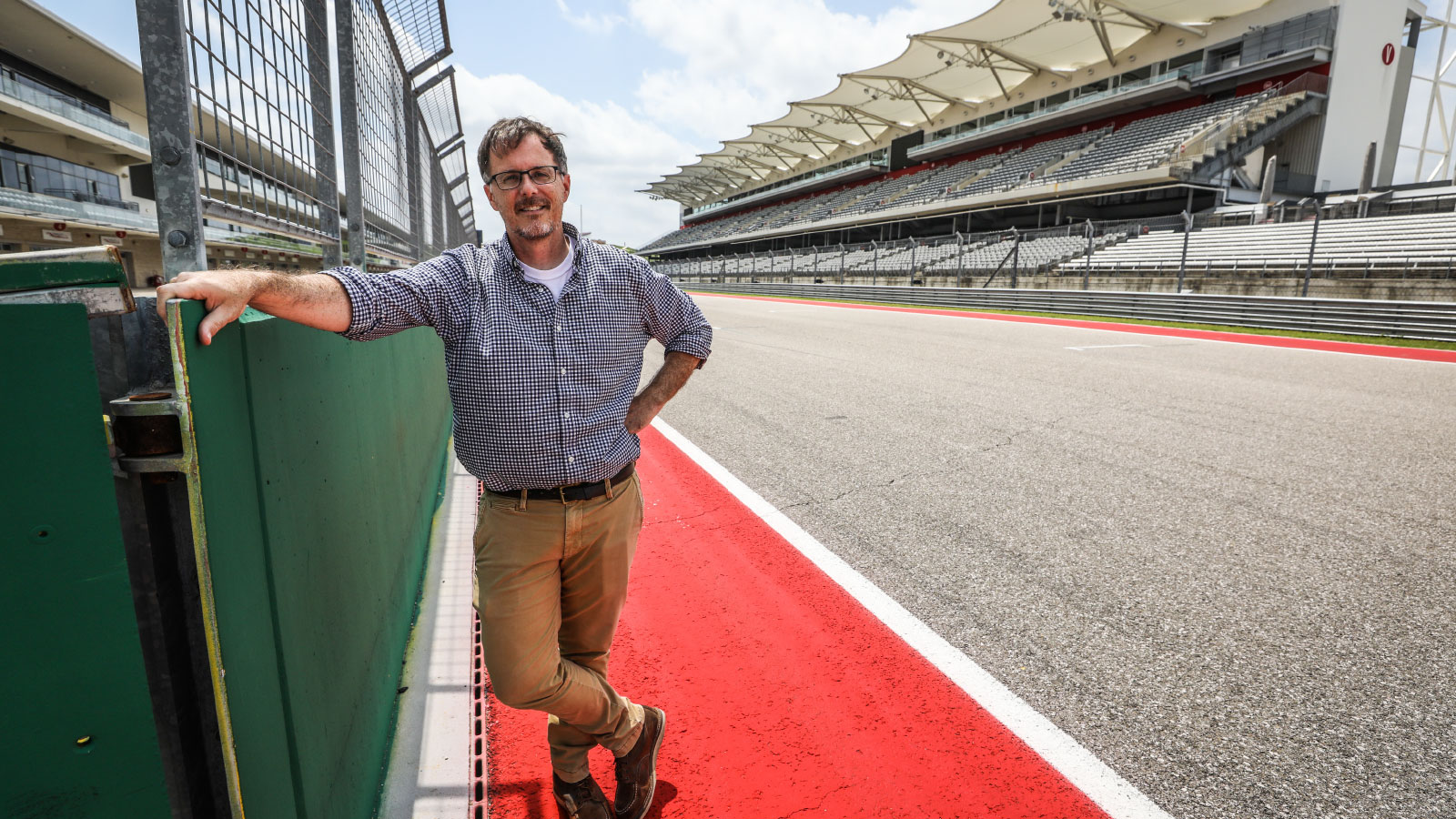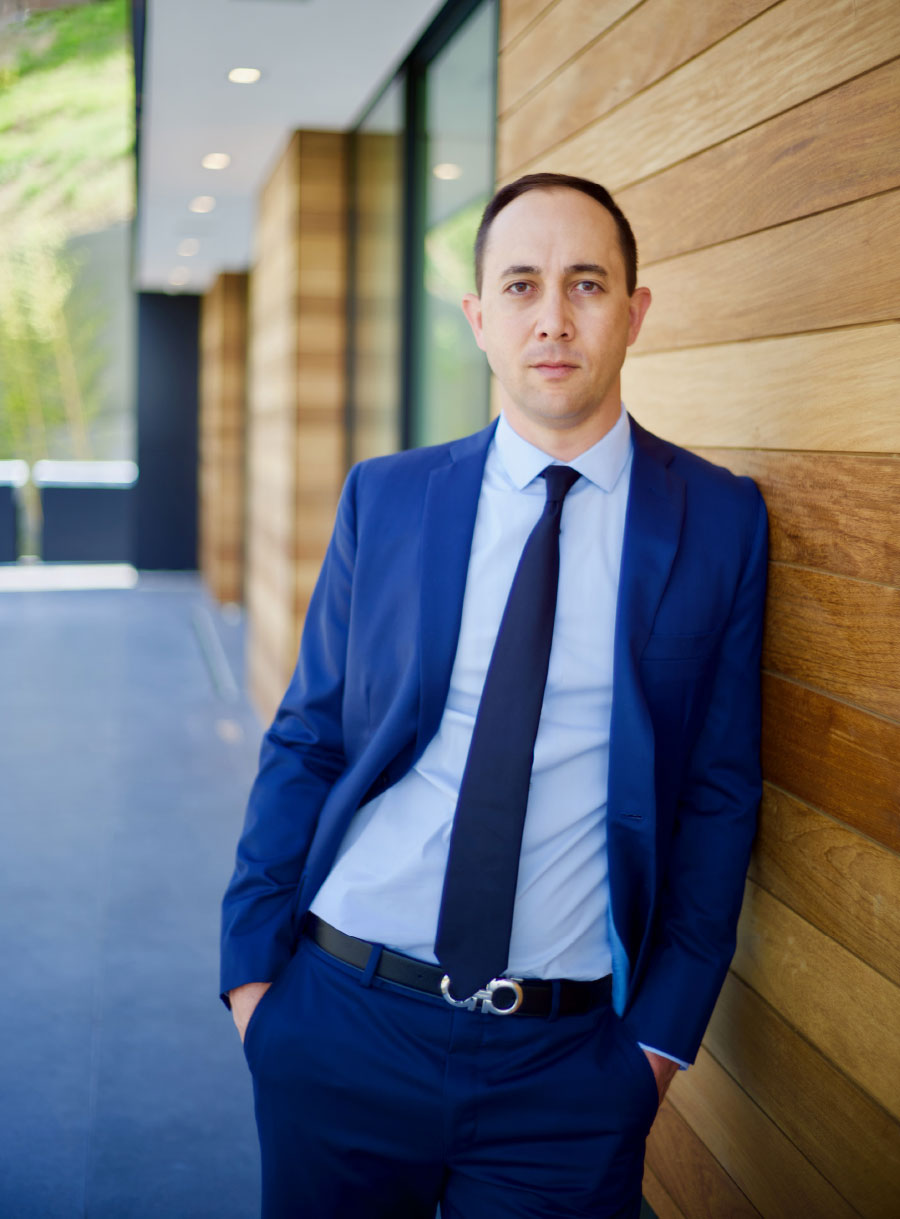Constructive Minds
Alumni follow different paths to chart innovative designs for golf, Formula One, residential and commercial projects.
Texas-native Chet Williams, BA ’83, moved with his family to Venezuela at age 7 when his father, who was in the oil business, was transferred to the South American country. He remembers playing golf as early as age 6; by age 10, he was sketching golf hole designs he had played or seen on television.
“It was something I liked doing, having no idea that it was something you could do for a living,” Williams says.
Five years after graduating from Baylor with an economics degree, Williams began a 25-year career with Nicklaus Design — the golf course design company of legendary World Golf Hall of Famer Jack Nicklaus.
Ken Jones, BA ’96, realized as a Baylor junior that medicine was not his desired career path. His advisor suggested that Jones, who had been a Homecoming float and Sing chair for his fraternity, reconsider architecture.
Jones has worked for Miró Rivera Architects in Austin since 2001. Many of his projects, including his work on components of the Formula One Circuit of the Americas (COTA) race track complex, have received recognition for their design excellence and have appeared in national publications.
“I wouldn’t be an architect today if I hadn’t pledged a fraternity,” Jones says. “I was able to do things that are not classroom experiences through which I learned about project management and putting things together and balancing things in life.”
“I was able to do things that are not classroom experiences through which I learned about project management and putting things together and balancing things in life.”Ken Jones, BA ’96
Ameen Ayoub, BA ’01, was born in El Paso and grew up wanting to be an architect. Ultimately, he was attracted to Baylor’s art department.
He now owns Ameen Ayoub Design Studio, a leading contemporary design firm in Los Angeles. Ayoub personally designs each project, including innovative residential and commercial properties.
“I knew I could get on track to architecture through the art department,” Ayoub says. “I wasn’t attracted to the architecture program because Baylor didn’t have one.”
Each of these Baylor graduates has carved a renowned career in the field by following a calling built upon University experiences that prepared the way.
Finding Answers
Jones believes the value of his Baylor education reaches beyond a specific academic program. During his freshman year, one of his professors told students not to expect to be taught answers but to be taught how to find answers.
“That’s a fantastic basis for architecture,” Jones says. “I took a circuitous route to architecture through Baylor. I wouldn’t trade it for the world because at Baylor, I learned how to learn.”
Jones, who grew up in Jefferson City, Missouri, says he liked to draw as a child and that his mother was always reminding him to pick up his Legos. As a National Merit Scholar, he chose Baylor over schools with specific architecture programs.
“The options to pursue architecture that my high school guidance counselor presented to me didn’t seem as appealing as Baylor did in general,” he says.
At the time, Baylor offered a Bachelor of Arts in architecture, but it was through a cooperative program with Washington University in St. Louis. Students completed 94 hours of core requirements at Baylor before transferring to Washington’s School of Architecture. Baylor then conferred the Bachelor of Arts after the completion of the first year of professional courses at Washington.
“I didn’t find out about the program until my junior year,” Jones says. “I spent my final year at Baylor in the art department instead of the biology department, which was eye opening to say the least. It was the right thing for me.”
Jones completed his graduate work at the University of Texas at Austin, where Juan Miró was one of his professors. Upon completion of his master’s degree, Jones requested a recommendation from Miró, whose lone recommendation was an offer to work for the newly formed Miró Rivera Architects. Jones took
the job when his wife was seven months pregnant with the couple’s first child.
“In my opinion, it was the best option for a young architect coming out of school in Austin,” Jones says. “Here we are 18 years later.”
During that time, Jones has led a wide range of projects. He was the project architect for the COTA Main Grandstand and Grand Plaza, which includes the Austin360 Amphitheater and Observation Tower. COTA hosted the inaugural U.S. Formula One Grand Prix in 2012.
Jones also completed a 30,000 square-foot building and campus master plan for Lifeworks, an Austin-based nonprofit dedicated to transitioning youth and families from crisis to safety and success. He says it was the first nonprofit facility to receive a 5-star sustainability rating from the Austin Energy Green Building program, the nation’s first green building program and the model for the LEED certification system.
“That’s part of what makes our firm so interesting,” Jones says. “I’ve done everything from a single vehicular gate for a private residence all the way to Circuit of the Americas, and just about everything in between.
“One of the things that drew me to this firm is that we don’t have a specialization. Some firms do hospitals. Some firms do office buildings. Some firms do schools. We’re interested in good design solutions to problems. We’re able to bring a unique perspective to each of these projects.”
Jones says most architects enter the field because they believe in the importance of using space to enhance life. He says the Lifeworks facility is a prime example.
“It’s rewarding to get feedback from people working in that building about how much it improved their day-to-day productivity,” Jones says. “And, it’s rewarding to hear the population that Lifeworks serves say, ‘We walk in this place, and it feels like home. We feel like people care about us because of the way this building is put together.’”
Jones is also pleased to have produced one of the most sustainable buildings in Austin, a place that takes pride in being a leader in environmental efforts.
“We were able to do it on a nonprofit’s budget by focusing our efforts to bring in sustainable technologies where they supported the program,” he says. “We didn’t green-wash the building and make it look sustainable; we really used those sustainable features to serve the purpose of the building.”
Through Miró Rivera, Jones has worked on projects in Austin, Dallas and Houston, as well as in Mexico and Europe. Miró is from Spain, while Miguel Rivera, the firm’s other founding partner, is from Puerto Rico.
“It’s in our DNA to have a more international perspective,” Jones says. “That’s allowed us to fit into a lot of different building environments.”
Jones says his ability to understand different environments is thanks, in part, to his educational experience at Baylor.
“I have friends from college who are lawyers, doctors, bankers, accountants because at Baylor, that’s the kind of people you meet,” he says. “In architecture school, I only met architects.”
Honing Skill Sets
Likewise, Ayoub believes spending his first three years at Baylor made him a more well-rounded person.
“Any program at Baylor is a good blend of academics, campus life and social life. It was a holistic package,” Ayoub says. “Baylor trains you to have a well-rounded feel for academics and the larger context of what you have to get out and do.”
He looked at other universities before choosing Baylor.
“I graduated from a smaller high school in El Paso, and I identified with Baylor’s size at the time, with the value system, that it was a Christian school,” he says. “I was attracted to the campus and the campus life.”
Like Jones, Ayoub was active in his fraternity and involved in various campus activities. He credits part of his professional success to being socially active in college.
“Baylor trains you to have a well-rounded feel for academics and the larger context of what you have to get out and do.”Ameen Ayoub, BA '01
“Baylor prepares you for life,” Ayoub says. “More than half my job is interacting with clients and getting to know people in the community. Baylor is a great place to hone all of your skill sets — not only the academic side.”
Ayoub completed his graduate work at Washington before working at some residential offices. He then spent time with HKS Inc., an international architecture firm headquartered in Dallas. While with HKS, he worked briefly on AT&T Stadium in Arlington and Dodgers Stadium in Los Angeles.
While in graduate school, Ayoub was influenced by modern and past master architects. He was drawn to the architecture of legendary Frank Gehry, who has designed some of contemporary architecture’s most influential buildings such as his residence in Santa Monica, California.
“Frank’s work most exemplified how I felt about what architecture could be as opposed to what it should be,” Ayoub says. “His understanding of space, light and form, and his unique vision of how to use them is what excited me.”
In 2010, Ayoub was given the opportunity to work as a designer for Gehry’s new Guggenheim Abu Dhabi, a planned art museum in the United Arab Emirates.
“I was beyond thrilled,” Ayoub says. “Working at the top of the architecture world and the day-to-day collaboration with Frank and the design team was a second-to-none experience.
“As a young architect, you need to have these experiences to test what you believe in. I made the most out of my time there and see it as a pivotal moment in my career that shaped my ideas on where my own architecture and design would eventually go.”
Ameen Ayoub Design Studio was founded in 2006 and has since completed residential and large industrial buildings, and office renovations. While he focuses on residential design work in Los Angeles, Ayoub also collaborates with artists, architects and designers on various projects from art gallery installations to international competitions and projects.
He currently has three private, single-family residential projects — each more than 25,000 square feet in size — that are in various planning phases. One of these is on the same lot as a Frank Lloyd Wright home in the middle of a city park. The new house will be buried in a hillside, inspired by Native American cliff dwellings in the American Southwest. It will be the main residence with the Wright home becoming a guest house.
Ayoub envisions future projects in cities throughout the world, including museums and mixed-use projects. As an example, he cites he design of a drone arena in Houston that is used for drone races.
“My professional life is a dream come true due to perseverance, hard work and an opportunity to receive a high-caliber education,” Ayoub says. “The foundation for everything that has been good and successful in my life and career started with my education.”
His education began at Baylor. Ayoub admits he had no idea as a Baylor freshman what his career would eventually be.
“I knew the education I would receive at Baylor would lead me in the right direction,” he says. “I was in the right place to make my dreams come true and had a path to follow.”
Going for Greens
Williams, meanwhile, never considered any school other than Baylor. His family returned to Texas in his teens, and he graduated from Humble High School.
“Baylor was really the only place I ever wanted to go, primarily because it’s a Christian school,” Williams says. “When I got to Baylor, I still hadn’t realized that golf course design was a profession. I guess I thought courses — poof — appeared out of nowhere or something.”
Williams admits to having youthful aspirations of playing professionally that dissipated soon after beginning college. As an international business major, he became interested in Baylor’s recently developed environmental studies program and took a few courses.
“In a roundabout way, I’ve been able to use a lot of things I learned from those classes in my profession,” Williams says. “Not directly related to golf courses; but, whether it’s wetlands or protected plant species or protected animals, there’s something you have to work around.”
Those were not the only Baylor classes Williams says prepared him professionally. He remembers the difference between the structure at his American school in Venezuela compared to what he encountered at Baylor.
“When I came to Baylor, it was the first time I got heavily into doing things as a group,” Williams says. “In business, obviously, you have to deal with clients. Baylor helped prepare me to deal with other people that are in different professions but working together as a team to pull together a golf course project.”
"Baylor helped prepare me to deal with other people that are in different professions but working together as a team to pull together a golf course project.”Chet Williams, BA '83
After graduating from Baylor, Williams entered the landscape architecture master’s program at Texas A&M University. As he studied grading, drainage, irrigation and construction, his future profession took shape.
“Probably 75 percent of the people who were golf course designers, their educational background was landscape architecture,” he says. “There were no golf course design classes, but the head of the department let me tailor my design projects to incorporate some of that. But I did my share of plaza and office complex design.”
After completing his master’s degree, Williams worked for Dallas-based course designer Jeff Brower. A few years later, Williams landed an interview with Nicklaus Design. He was offered a job on the spot.
Over the next 25 years, Williams worked on 24 courses for Nicklaus Design in all parts of the world and on all types of terrain.
“The many experiences Jack afforded me undoubtedly played a big part in the designer I am today,” Williams says. “There were times when the company would have 30 projects under construction worldwide and maybe four or five of those were mine. Jack was still playing a lot of golf back then, so I was his eyes and ears, his representative on those projects.”
In the early days of his course design work, Williams says he envisioned individual areas rather than the entire course. He developed an eye for seeing how the course would interface with the surrounding environment, whether it be a planned residential community or a natural habitat. Still, there can be challenges.
“I’ve built a golf course on the side of a mountain in South Korea,” he says. “That one I could not see before we started.”
While with Nicklaus Design, Williams designed courses in Colombia, Japan, South Korea, Mexico and throughout the United States. Perhaps his crown jewel in that time was Whispering Pines Golf Club in Trinity, Texas. Opened in 2000, the course consistently ranks in Golf America’s Best Courses in America, and the Dallas Morning News has ranked Whispering Pines as the best course in Texas each year since 2006.
Williams, who lives and works out of Leroy, Texas, left Nicklaus Design in 2013 and established Chet Williams Design, through which he has designed six courses and done two bunker renovations. In 2016, he was asked to design Baylor’s Billy W. Williams Golf Practice Facility.
“That was a special project, and it’s always nice to work this close to home,” Williams says. Baylor men’s golf head coach Mike McGraw says the facility gives Baylor’s men’s and women’s golf student-athletes a major advantage.
“We have something that takes a back seat to no other facility in collegiate athletics,” McGraw said at the facility’s dedication.
Today, Williams has on-going projects in the Dallas area and a potential course in Spain. Additionally, he hopes to design another course in Colombia.
“It reminds me a lot of Venezuela when I was a kid,” Williams says. “I’m willing to go anywhere as long as I feel safe. I’ve dealt with soil all over the world. I’ve probably brought a little back on the bottom of my shoes.”


